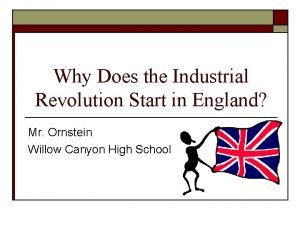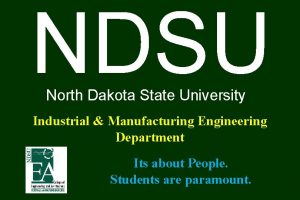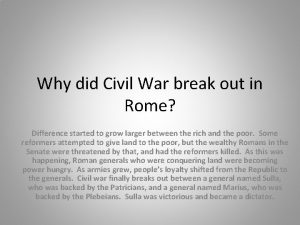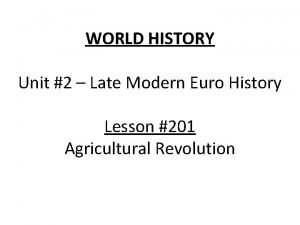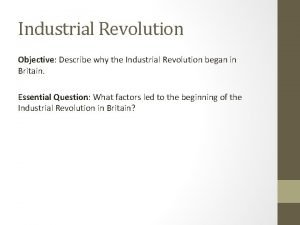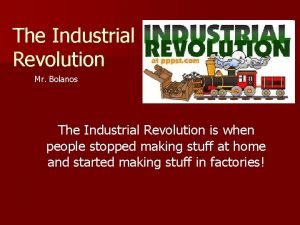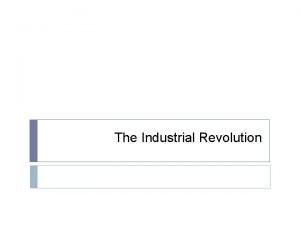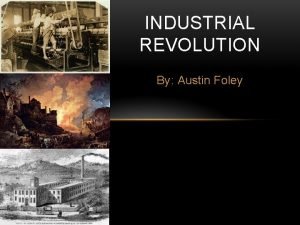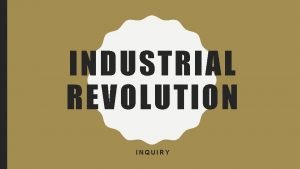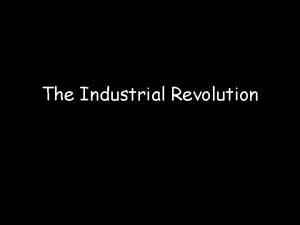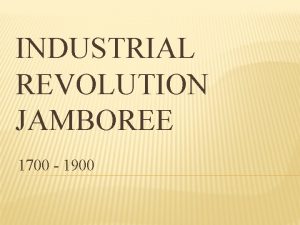Industrial Revolution Why the Industrial Growth The Civil



















- Slides: 19

Industrial Revolution

Why the Industrial Growth? The Civil War challenged industries to make goods more quickly and efficiently The government encouraged immigration to meet the increasing demand for labor in the nation’s factories – In 1881 alone, nearly three quarters of a million immigrants arrived in the US – workforce grows Industrial growth can be attributed to the abundance of natural resources in the US – coals, forests, oil (kerosene and gasoline) Inspiring books are written encouraging entrepreneurs Government encourages free enterprise and wants business to be successful – protective tariffs and the principles of laissez-faire

Innovation Drives the Nation By the late 1800 s the drive for innovation and efficiency seemed to touch every sphere of life – the number of patents increased rapidly during this time Electricity Thomas Edison established a research laboratory in Menlo Park, NJ in which he would receive more than 1, 000 patents for new inventions – Edison and his team are most notably known for the light bulb but also are known for developing central power plants to light entire sections of cities. Edison’s work would later get improved by other inventors. Communication 1844 – Samuel Morse – Telegraph technology or sending messages over a wire 1876 – Alexander Graham Bell patented the telephone 1896 – Guglielmo Marconi invented the wireless telegraph By 1900, there were more than one million telephones in the United States Steel 1850 – English man Henry Bessemer developed a process for purifying iron, resulting in strong, but lightweight steel. The Bessemer Process quickly made its way to American industries By 1890, the US was out producing British steel manufacturers. – Strong steel would eventually lead to the building of suspension bridges and skyscrapers

Innovation Drives the Nation Railroads 1869 – George Westinghouse patents air brakes for trains 1887 – Granville Woods patents a telegraph system for trains Gustavus Swift patents refrigerated rail cars By 1883 there were three transcontinental railroads in the US Problems were caused in the railroad industry because of time – led to the development of time zones in the US in 1884 City Transportation Electric streetcars, commuter trains, and subways appeared in major cities Americans living outside the city can now easily commute to work – suburbs Factory production of automobiles with gas powered engines began in 1902 Flight 1903 – First successful airplane flight by two bicycle manufacturers, Orville and Wilbur Wright marked the birth of the aviation industry

Resources and Transportation An abundance of natural resources and an efficient transportation system to carry raw materials and finished goods set up a spiral of related growth Railroad cars could efficiently get supplies to factories, which in turn the factories could use these supplies in a system of mass production to make goods quickly and inexpensively.

Impact of Industrialization Linking World Markets By 1880, American exports of grain, steel, and textiles dominated international markets Changing American Society Farms became mechanized Mass production of goods meant new urban dwellers had easy access to clothing and supplies they would have had to make by hand in the past – yet they faced higher costs of living, were dependent upon cash wages to buy food, and performed repetitive work in factories. Thinking About the Environment In the early 1800 s, few worried about how industry might effect the environment – by the late 1800 s, industrial waste had risen dramatically and mining had begun to destroy the land In the Midwest, increasing agricultural production had led to soil erosion and dust storms People became concerned about protecting natural resources – Congress responded by setting aside protected lands that would eventually become the National Park Service – Yellowstone Park in 1872 was among the first

The Rise of Big Business Corporations develop – a number of people share the ownership of a business Corporations were good for risky industries, and were suited to expand markets due to their huge amounts of capital or invested money. Corporations sought to maximize profits by paying the least they needed to for raw materials and paying their workers the least possible – this insured their products were priced below that of competitors Some corporations tried to become monopolies – to have complete control of a product or service Some like John D. Rockefeller, an oil tycoon, made deals with railroad companies

Horizontal and Vertical Integration Business sought was to decrease cost and maximize profit Horizontal Integration – Consolidating many firms within the same business Vertical Integration – Allowing businesses to gain control of the many different businesses that make up all phases of a product’s development – allows companies to reduce costs and charge higher prices to competitors

Debating the Role of Big Business Many believed that consumers were harmed by the unfairly high prices that monopolies and cartels set on their products – because of big business’ capacity to swindle the poor, shrewd capitalists became known as “robber barons. ” At the same time, however, many people believed that business leaders served the nation positively, thus earning the nickname “captains of industry” – large businesses created jobs and even some business leaders like Carnegie, Vanderbilt, and Rockefeller were important philanthropists which established universities, museums, and libraries, believing that such institutions made it possible for the disadvantaged to rise to wealth.

The Government Imposes Regulations The railroad industry was renowned for practices such as fixing unfair rates The Interstate Commerce Commission was created in 1887, in the U. S. Senate, to oversee railroad operations. The government slowly became involved in regulating trusts In 1890 the Senate creates the Sherman Anti-Trust Act, which outlawed any trust that operated in restraint of trade or commerce The ICC and the Sherman Anti-Trust Act began a trend toward federal limitations on corporation’s power.

Factory Conditions In the 1880 s and 1890 s, employed factory workers were paid low wages in order for their employer to increase profit. Immigrants made up a large portion of this work force. Factory workers would often work 12 hour days, 6 days a week in small, dirty, often crammed workplaces referred to as sweatshops. They would be fined if they were late or exceeded their allowed time for breaks. Factory work was often dangerous – workplaces were poorly lit, often overheated, and badly ventilated. There were always more people than jobs so workers would be easily replaced.

Families in the Workforce Women frequently worked as laundresses, telegraph operators, and typists. Since many families had both parents needing to work to survive economically, many families would bring their children to work in order to keep them off the streets. By the end of the 1800 s, nearly one in five children between the ages of 10 and 16 worked rather than attending school. Conditions were often harsh for them and many suffered problems with physical and mental growth. By the 1890 s social workers began lobbying to get children out of the factories and into child care or schools. Eventually there efforts prompted states to pass legislation on child labor.

Living in Company Towns Many laborers, especially those who worked in the mining industry, were forced to live in isolated communities near their workplaces. The housing in these communities, known as company towns, was owned by the business and rented out to the employees. The employer also owned the “company store” where workers were forced to buy goods – the company store sold goods on credit but had a high interest – most of the employees wages would be owed back to the company store Since workers could be arrested if they left their jobs before they repaid their loans, employers could hold workers to their jobs through a system workers’ advocates called “wage slavery. ” Mexican, African Americans, and Chinese workers were often segregated in separate towns.

Early Labor Protests Factory workers tried to gain more power against their employers by using the technique of collective bargaining or negotiating as a group for higher wagers or better working conditions. One form of collective bargaining was the strike. Local strikes in some regions of the United States were able to achieve shorter workdays. The 10 -hour workday became more common in most New England factories.

Founding the Knights of Labor In 1869, Uriah Smith Stephens founded a labor union called the Knights of Labor – this union actively recruited African Americans – functioned largely as a secret society, devoted to broad social reform such as replacing capitalism with workers’ cooperatives. In 1881 Terrence V. Powderly took on the leadership of the Knights. He was the son of Irish immigrants who continued to lead workers out of the bondage of wage labor – he encouraged boycotts and negotiation with employers while abandoning the secretive nature of the union. By 1885, the Knights had grown to include some 700, 000 men and women nationwide, of every race and ethnicity. By the 1890 s, however the Knights had largely disappeared. This can be attested to a series of failed attacks including the Haymarket Riot.

Forming the AFL An English immigrant named Samuel Gompers formed the American Federation of Labor – The AFL was a craft union which focused on skilled workers from some 100 local unions devoted to specific crafts or trades Unlike the Knights which focused on larger social gains for workers, the AFL focused on more specific issues like wages, working hours, and working conditions. Because of its’ narrow focus it was nicknamed the “bread and butter” union. The AFL was not as successful as the Knights in gaining membership, partly because of its own policies. It opposed women members, because Gompers believed their presence would drive wages down. While the AFL was open to African American members, many local branches found ways to exclude them.

Strikes Rock the Nation Haymarket Riot On May 1, 1886, thousand of workers held a national demonstration in which they were seeking an 8 hour workday Strikes erupted in several cities and fights broke out between strikers and strikebreakers. On May 4, protestors gathered at Haymarket Square in Chicago. A frenzy broke out when a protestor threw a bomb, killing a policeman. Dozens of people, both protestors and police officers were killed. The Haymarket Riot left an unfortunate legacy and led to the fizzle of the Knights of Labor since people were associating union activities with violence. Homestead Strike Summer of 1892, a Carnegie steel plan in Pennsylvania cut workers’ wages. The union called a strike. Carnegie’s partner Henry Frick responded by bringing in the Pinkertons, a private police group known for their ability to break up strikes. The Pinkertons killed several strikers and wounded many others during the two week stand-off. On July 23 rd, an anarchist tried to assassinate Frick. The public associated this attempt as being union sponsored. In fear of losing their reputation the union called off the strike. The strike involved troops and local militia to suppress.

Strikes Rock the Nation Pullman Strike In 1893, the Pullman Palace Car Company laid off workers and cut their pay by 25%. The owner George Pullman required that workers lived in company towns and controlled their rents and prices of goods. In May 1894, workers sent a delegation to try to negotiate with Pullman; he responded by firing three of them and shutting down the plant. The workers turned to Eugene Debs and the American Railway Union (ARU). The ARU called a national strike. By June 1894, nearly 300, 000 rail workers had walked off their jobs. The Pullman Strike halted both railway traffic and mail delivery. On July 4, Grover Cleveland sent in federal troops, ending the strike. When Debs refused he was arrested for conspiring against interstate commerce. The strike was stopped by the government.

Effects on the Labor Movement The Labor Movement made people aware of the mistreatment of employees during the Industrial Revolution. Contract negotiations, strikes, and legislation would become the life for American industry. Violence by anarchists hurt the reputation of unions as many associated unions to violence In the decades after the Pullman Strike, the labor movement split into different factions, some increasingly influenced by socialism. Socialism – an economic and political philosophy that favors public, instead of private, control of property and income. Socialists believe that society at large, not just private individuals, should take charge of a nation’s wealth. Wealth they argue should be distributed equally to everyone. Eugene Debs spreads socialism and creates his Industrial Workers of the World union which became a radical violent group. Debs would later run for President with the American Socialist Party in 1900.
 Pictures
Pictures Why did the industrial revolution start in britain
Why did the industrial revolution start in britain Civil rights and civil liberties webquest
Civil rights and civil liberties webquest Russian revolution vs french revolution
Russian revolution vs french revolution Could the french revolution have been avoided
Could the french revolution have been avoided Definition of third agricultural revolution
Definition of third agricultural revolution Dont ask why why why
Dont ask why why why Absolute growth rate and relative growth rate
Absolute growth rate and relative growth rate Ground tissue
Ground tissue Growthchain
Growthchain Primary growth and secondary growth in plants
Primary growth and secondary growth in plants Chapter 35 plant structure growth and development
Chapter 35 plant structure growth and development Geometric vs exponential growth
Geometric vs exponential growth Neoclassical growth theory vs. endogenous growth theory
Neoclassical growth theory vs. endogenous growth theory Organic growth vs inorganic growth
Organic growth vs inorganic growth Ndsu civil and industrial engineering building
Ndsu civil and industrial engineering building Why did civil war break out in rome?
Why did civil war break out in rome? Why do civil war battles have two names
Why do civil war battles have two names Why was the civil war the first modern war
Why was the civil war the first modern war Enclosure movement
Enclosure movement

